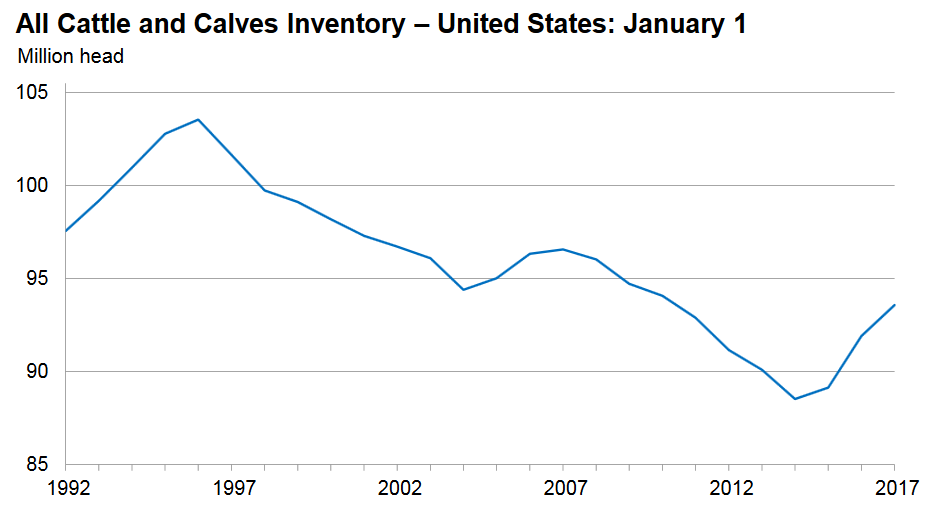By Doug Mayo
The U.S. Department of Agriculture (USDA) released their January cattle inventory report on January 31st. For the beef cattle industry this is the annual supply report card. The total number of cattle and calves rose 2% from 91.9 million head on January 1, 2016 to 93.6 million on January 1, 2017. This is the third straight year of increase in total inventory.


The total inventory of cattle was up 2% as of January 1, 2017 as compared to 2016, but there were differences among the individual categories of cattle. The inventory of breeding beef cows was up 3%, calf crop up 3%, bred heifers up 2%, and open replacement heifers up 1% as compared to last year. The dairy cow inventory was up only 39,000 head, while bred and open dairy replacement heifers were down 1%. Cattle on feed was also down slightly, 1% or 90,000 head from the previous year.
US cow-calf operations have been building up the breeding herd for the past four years. The chart below shows that since 2014 breeding beef cow inventory in the US have increased 7%, while over that same four year period, beef replacements have increased 16%. Some of this increase was certainly influenced by a significant increase in cattle prices, but it was also greatly influenced by above average rainfall in the Southwest the ended long-term droughts in that region.

This beef herd expansion has not been the same across the country. I have had a number of cattlemen ask about herd expansion, because they have not noticed a dramatic increase in their home area. This is true; The increases to the breeding herd in the Southeast have not been as significant. The chart below shows the numbers reported for number of cows that calved from four southeastern states as compared to Texas and Oklahoma in 2017 and 2014.

Beef herd expansion since 2014 has not been the same nationwide. Texas and Oklahoma have seen double digit growth in the inventory of calving cows over the past four years. Much of this relates to the boost El Niño rains provided to range and pastures in that region in 2015-16. In comparison, the beef herd inventory in Southeast has remained relatively stable and has not seen significant expansion. Both Florida and South Carolina had a less than 1% increase in the number of calving beef cows. Alabama was the only state in the Southeast that had modest increase of 12,000 head increase over this four year period. In Georgia, the beef herd actually decreased slightly by 3,000 head.
The big question that remains to be answered is how steep declines in cattle prices last year will influence beef herd expansion in the years ahead. Market prices do have a significant effect on all types of commodity production. As prices rise, producers expand, and as they decline, they reduce. The cattle industry is unique, as compared to other livestock or crop commodities.The big difference with the cattle business is that the reaction time is much slower. It takes several years to really expand, and if reductions are made too quickly the market gluts causes prices for cull animals to drop dramatically below the level of investment. With this increase in supply, it does not appear that cattle prices will be rising for a while, unless the export market or US consumption improves demand significantly. But with retail prices falling lately, prices may stabilize some as consumer demand adjusts to a lower price range.
Source:ufl.edu